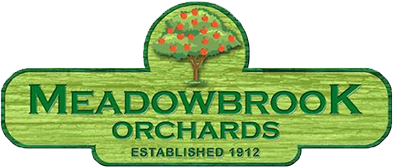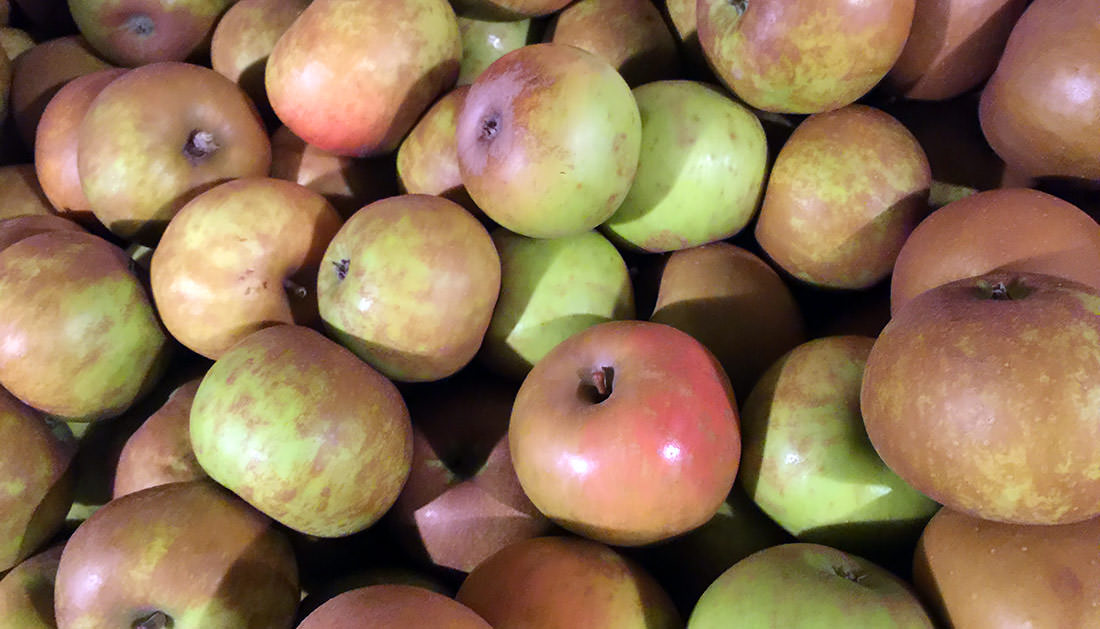Meadowbrook Orchards grows eight varieties of apples. Four of these are available for Pick Your Own.
Cortland: Cortland is a child of McIntosh and Ben Davis. It was an early success of the New York Experiment Station, which made the cross in 1998. Cortland is larger than McIntosh. The thin tearing skin reveals crisp, paper-white flesh. The flavor is tart and tangy, but not emphatically so, and juicy to the point of messiness. In short, Cortland comes across as friendly; it’s not a complex variety that will flood your sense gates, but it makes a good apple to accompany your sandwich. Or try it in pies and sauces. Cortland is suited for fruit salads because slices are usually slow to brown, although an all-Cortland cider is apt to look watery.
Empire: This cross between the best-selling red varieties Red Delicious and McIntosh was introduced in 1966. Empire has proved superior to the parent it most resembles, Mac, in redness, flavor and post-harvest life. Not surprisingly, Empire has caught on with both the growers and the apple-eating public. The creamy white flesh is crisp and juicy. Right off the tree, Empire is an excellent choice for eating out of hand if you like a loud, snapping apple that’s sweeter than it is tart. Empires are frequently added to cider blends and can be used for cooking. In storage, these apples keep their quality well.
Golden Russet: Golden Russet is an early American apple, believed to have sprouted from a seed of an English Russet. It was a commercially marketed variety by the early 1800s and won a following. The yellow flesh is crisp, fine-textured, and brightly flavorful, with a noticeable sweetness that made it a traditional favorite for hard cider. The apples can be used for cooking and drying. As with most russets, the apples keep well, but they need humid storage so they don’t get soft under the skin.
Macintosh: The McIntosh apple is a small- to medium-sized round fruit with a short stem. It has a red and green skin that is thick, tender, and easy to peel. Its white flesh is sometime tinged with green or pink and is juicy, tender, and firm, soon becoming soft. The fruit is considered “all-purpose”, suitable both for eating raw and for cooking. It is used primarily for dessert, and requires less time to cook than most cultivars. It is usually blended when used for juice.
Macoun: Macoun has fans who hunt roadside stands for a bushel or two. Introduced in 1923, Macouns are a prodigy of the New York State Agricultural Experiment Station. The apple has some resemblance, in taste and appearance, to its parent, McIntosh (bred with Jersey Black), but with a darker red over the underlying green and a flavor that many prefer to Mac. The white flesh is firm, aromatic, and juicy. This is a good pie apple.
Paulared: A red fall apple that matures in summer, Paulared has a beautiful solid red blush color far ahead of other apples. The flavor is tart with light to creamy flesh that is as good for cooking as it is for eating. Paulareds will store well when refrigerated.
Red Delicious: Red Delicious is a marketer’s ideal: as intensely red as the apple in Sleeping Beauty, instantly recognizable, tall and wasp-waisted, gorgeous and big! Riding on these qualities, the variety has pushed regional favorites aside. The skin is thick and bitter and has to be chewed vigorously. At its best the yellow flesh can be juicy and somewhat tart, and highly aromatic. this apple does not hold up well when cooked.

